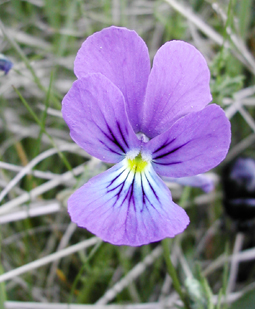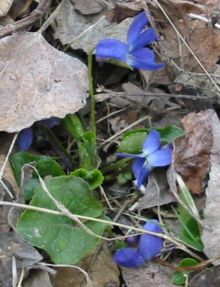Viola
| Violets | |
|---|---|
 | |
| Genus: | Viola |
| Family: | Violaceae |
| Type: | Herbaceous perennials and annuals |
Violets (Viola) are a genus of plants in the family Violaceae, with around 400-500 species throughout the world, mainly in the temperate Northern Hemisphere but also in Hawaii, Australasia, and the Andes in South America. They are typically found in moist and slightly shaded conditions such as hedgerows.
Generic Characteristics
[edit | edit source]Most violets are small perennial plants, but a few are annual plants and some are small shrubs. They typically have heart-shaped leaves, and asymmetrical flowers with four upswept or fan-shaped petals, two each side, and one broad, lobed lower petal pointing downward. The shape of the petals defines many species, for example, some violets have a "spur" on the end of each petal. Flower colours vary in the genus; many are violet, some are blue, some yellow, some white, some cream; some are bicolored, often blue and yellow. Flowering is often profuse, and may last for much of the spring and summer depending on the species.
One quirk of some violets is the elusive scent of their flowers; along with terpenes, a major component of the scent is a ketone compound called ionone, which temporarily desensitises the receptors in the nose; this prevents any further scent from being detected from the flower.
Species
[edit | edit source]See List of Viola species for a more complete list.
- Viola arvensis - Field Pansy
- Viola banksii - (Australian) Native Violet
- Viola biflora - Yellow Wood Violet or Twoflower Violet
- Viola canina - Heath Dog Violet
- Viola hirta - Hairy Violet
- Viola odorata - Sweet Violet
- Viola pedunculata - Yellow Pansy
- Viola pubescens - Downy yellow violet
- Viola riviniana - Common Dog Violet
- Viola stagnina - Fen Violet
- Viola tricolor - Wild Pansy or Heartsease
- (Note: Neither Saintpaulia ("African violets") nor Erythronium dens-canis ("Dogtooth violet") are related to the true violets.)
The genus includes the Dog Violets, a group of scentless species which are the most common violets in many areas, the Sweet Violet Viola odorata (named from its sweet scent), and many other species whose common name includes the word "violet". Several species are known as pansies, including the Yellow Pansy of the Pacific coast.
The Common Blue Violet Viola sororia is the state flower of Rhode Island, Illinois, and New Jersey.
Australia is home to a number of violets, including Viola hederacea, Viola betonicifolia and Viola banksii, first collected by Joseph Banks and Daniel Solander on the Cook voyage to Botany Bay.
The modern Garden Pansy (V. × wittrockiana) is a plant of complex hybrid origin involving at least three species, Viola tricolor (Wild Pansy or Heartsease), Viola altaica and Viola lutea (Mountain Pansy).
Pests and Diseases
[edit | edit source]Arthropod pests
[edit | edit source]- Foxglove Aphid: Acyrthosiphon solani
- Melon Aphid: Aphis gossypii
- Buckthorn Aphid: Aphis nasturtii
- Violet Aphid: Aphis violae
- Green Peach Aphid: Myzus persicae
- Crescent-marked Lily Aphid: Neomyzus circumflexus
- Violet Aphid: Neotoxoptera violae
- Aster Leafhopper: Macrosteles facifrons
- Iris Whitefly: Aleyrodes spiroeoides
- Silverleaf Whitefly: Bemisia argentifolii
- Violet Leafgall Midge: Phytophaga violicola
- Snailcase Bagworm: Apterona helix
- Corn Earworm: Heliothis zea
- Greenhouse Leaf Tier: Udea rubigalis
- Variegated Fritillary
- w:Giant Leopard Moth
- w:Large Yellow Underwing
- w:Lesser Broad-bordered Yellow Underwing
- w:Setaceous Hebrew Character
- Violet Sawfly: Ametastegia pallipes
- Twospotted Spider Mite: Tetranychus urticae
Other Pests
[edit | edit source]Slugs and Snails White-tailed Deer
Uses
[edit | edit source]
When newly opened, violet flowers may be used to decorate salads or in stuffings for poultry or fish. Soufflés, cream and similar desserts can be flavoured with essence of violet flowers. The young leaves are edible raw or cooked as a somewhat bland leaf vegetable. Flowers, leaves and roots are also used for medical purposes, being rich in vitamins A and C.
A candied violet or crystallized violet is a violet flower preserved by a coating of sugar syrup. Hot syrup is poured over the fresh flower (or the flower is immersed in the syrup), and stirred until the sugar recrystallizes, and is dried. This method is still used for rose petals, was applied for orange flowers in the past (when almonds or orange peel are treated this way they are called as pralines). Candied violets are still made commercially at Toulouse, France, where they are known as violettes de Toulouse. They are used as decorating or included in aromatic desserts.
Violets are used to flavour the liqueurs Creme Yvette, Creme de Violette, and Parfait d'Amour.
Medicinal use
[edit | edit source]Violet flowers are also used to make an herbal tea that is used in Chinese herbal medicine.
References
[edit | edit source]- ITIS (Accessed December 2 2002)
- The Oxford Companion to Food, by Alan Davidson, Oxford University Press. ISBN 0-19-211579-0
- Larousse Gastronomique, by Prosper Montagne (Ed.), Clarkson Potter, 2001. ISBN 0-609-60971-8
Pirone, Pascal P. Diseases & Pests of Ornamental Plants. pp. 531–534. {{cite book}}: Cite has empty unknown parameter: |coauthors= (help)
Cranshaw, Whitney (2004). Garden Insects of North America. Princeton University Press. p. 625. {{cite book}}: Cite has empty unknown parameter: |coauthors= (help)